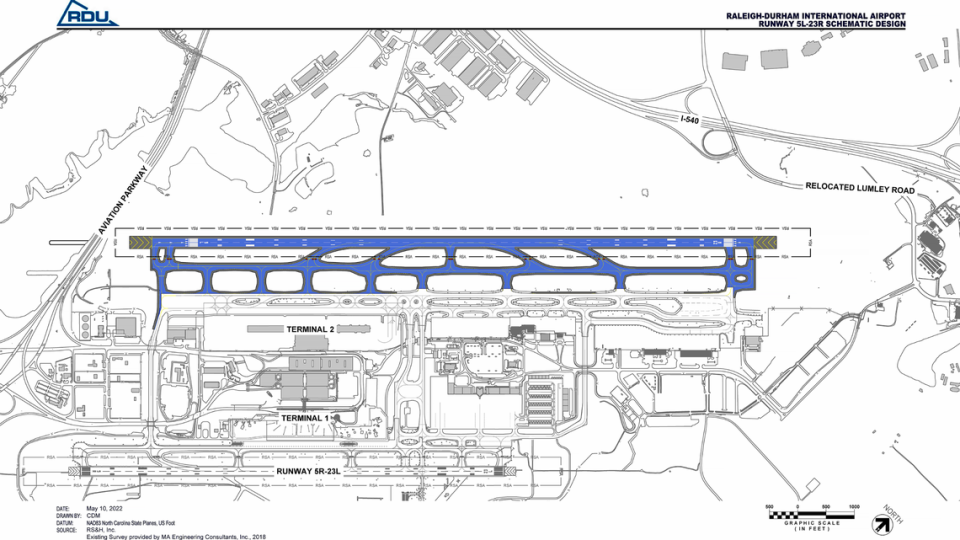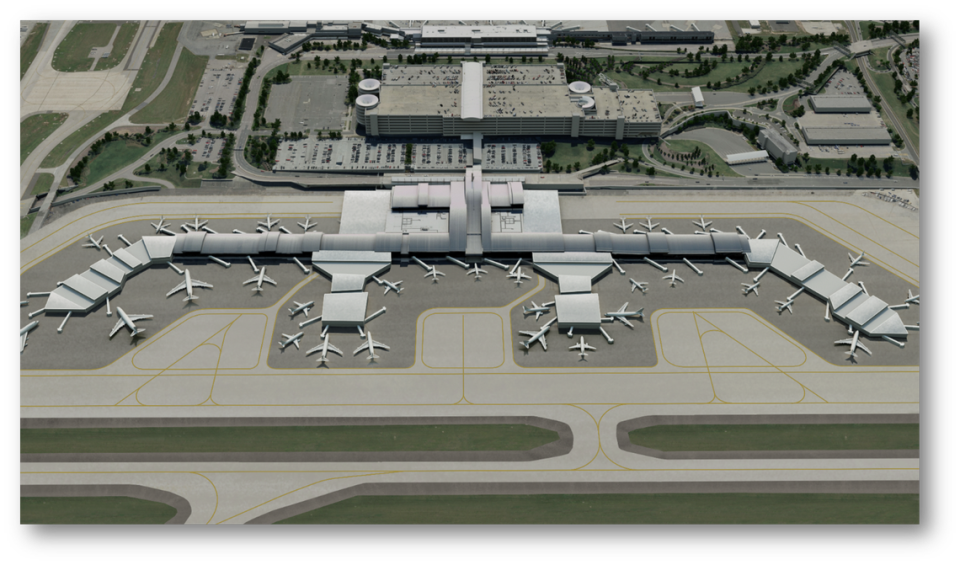FAA approves RDU’s plans to build ‘most important 2 miles of pavement in the Triangle’
Raleigh-Durham International Airport expects to begin work on its new main runway early next year, after the Federal Aviation Administration approved the project last week.
The new runway will be about 537 feet northwest of the existing one near Terminal 2, the largest and busiest of the two passenger terminals. After the new runway opens in late 2027 or early 2028, the existing one will be converted into a taxiway, a process that will take three to four years as contractors work while keeping the airfield open.
The existing runway, 5L/23R, was completed in 1986 and has shown its age for several years now. The airport has extended its life by replacing hundreds of slabs of crumbling concrete but says that’s not a long-term strategy.
RDU still needs state and federal environmental permits for the project and expects to receive those by the end of next summer, said Bill Sandifer, the airport’s chief development officer. In the meantime, contractors will begin some preliminary work — such as grading, pipe installation and fencing — this winter, Sandifer said.
The FAA’s decision is a milestone in replacing what airport president and CEO Michael Landguth calls “the most important two miles of pavement in the Triangle.” The runway handles the bulk of commercial traffic at RDU, including all large passenger and cargo planes.

RDU had initially hoped that it’s new runway would be 11,500 feet long or 1,500 feet longer than the existing one. The additional length would have allowed the airport to seek nonstop flights to Asia.
But after the sharp decline in air travel during the COVID-19 pandemic, RDU decided to pare down its ambitions, in part to reduce cost and potentially speed up FAA approval. In the end, the federal agency authorized a 10,639-foot runway, long enough for all cargo and passenger carriers now doing business at the airport to operate their planes fully loaded.
The added length and the required safety zone around the runway means RDU will have to move a section of Lumley Road and demolish buildings near where Lumley meets Mount Herman Road. The airport has already purchased those properties, including the former Ward Transformer Superfund site, and received permission from the N.C. Department of Transportation to relocate its road, at airport expense.
The demolition work will begin early next year, Sandifer said.
Where will the money come from?
The new runway is expected to cost more than $500 million. That money is expected to come from a variety of sources, including the state and federal governments and RDU’s own revenues from parking, landing fees and other income.
Congress has allocated $90 million to RDU, most through the big infrastructure bill passed in late 2021, Landguth said. Airport and FAA officials will meet in Memphis later this month to talk about additional support from the agency now that it has approved the runway, he said.
“We’re optimistic about what that will look like,” he said. “I think they’ve been unwilling to commit to that until they actually had a record of decision in their hand and they knew that we were moving forward with the project.”
Landguth said the runway is one part of a larger construction plan at RDU that will include new parking, additions to both passenger terminals and new ground transportation and rental car centers in and adjacent to the parking decks. Altogether, RDU expects to spend $2.8 billion on construction in the coming decade.
That money will come from a number of sources, including potentially borrowing, Landguth said.
“We feel good about where we’re at right now being able to fund the program,” he said.
Terminal expansion depends on new runway
Opening the new runway will allow RDU to begin adding new gates to Terminal 2.
The terminal has 36 gates now, though planes can occupy no more than 33 at a time because of space constraints on the tarmac. The airport hopes to eventually expand that number to 53, by building wings at either end and two more from the middle of the existing concourses.
Runways must be a minimum distance from passenger terminals, so shifting RDU’s farther west will provide room to expand the building, Sandifer said.
Meanwhile, RDU is likely to first begin adding gates to Terminal 1, on the east side of the airfield. Terminal 1 now has nine gates, serving three airlines, and this summer the airport board approved a $3.5 million contract to develop conceptual designs and renderings for a larger building.



